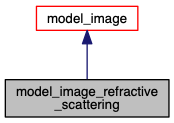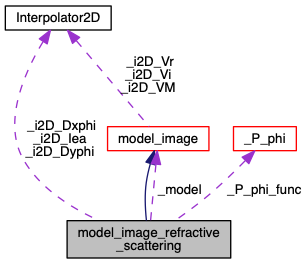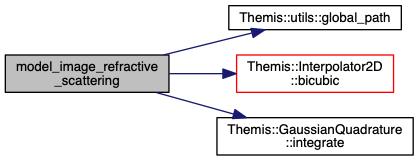|
| | model_image_refractive_scattering (model_image &model, size_t nModes, double tobs, double frequency=230e9, std::string scattering_model="dipole", double observer_screen_distance=2.82 *3.086e21, double source_screen_distance=5.53 *3.086e21, double theta_maj_mas_cm=1.38, double theta_min_ma_cm=0.703, double POS_ANG=81.9, double scatt_alpha=1.38, double r_in=800e5, double r_out=1e20, double vs_ss_kms=50.0, double vy_ss_kms=0.0) |
| |
| virtual size_t | size () const |
| |
|
virtual std::string | model_tag () const |
| | Return a string that contains a unique identifying tag for use with the ThemisPy plotting features.
|
| |
|
virtual void | generate_model (std::vector< double > parameters) |
| | Takes model parameters and generates scattered observables e.g. VA.
|
| |
| void | set_image_resolution (size_t nray) |
| |
| void | set_screen_size (double fov) |
| |
|
void | get_unscattered_image (std::vector< std::vector< double > > &alpha, std::vector< std::vector< double > > &beta, std::vector< std::vector< double > > &I) const |
| |
|
void | get_ensemble_average_image (std::vector< std::vector< double > > &alpha, std::vector< std::vector< double > > &beta, std::vector< std::vector< double > > &I) const |
| |
|
void | get_image (std::vector< std::vector< double > > &alpha, std::vector< std::vector< double > > &beta, std::vector< std::vector< double > > &I) const |
| |
| virtual void | set_mpi_communicator (MPI_Comm comm) |
| |
|
virtual void | generate_complex_visibilities () |
| | A one-time generate function that will generate the complex visibilities and store them. This must be called after generate_model has been called.
|
| |
|
virtual std::complex< double > | visibility (datum_visibility &d, double accuracy) |
| | Returns complex visibility in Jy computed from the image given a datum_visibility_amplitude object, containing all of the accoutrements. While this provides access to the actual data value, the two could be separated if necessary. Also takes an accuracy parameter with the same units as the data, indicating the accuracy with which the model must generate a comparison value. Note that this can be redefined in child classes.
|
| |
|
virtual double | visibility_amplitude (datum_visibility_amplitude &d, double accuracy) |
| | Returns visibility ampitudes in Jy computed from the image given a datum_visibility_amplitude object, containing all of the accoutrements. While this provides access to the actual data value, the two could be separated if necessary. Also takes an accuracy parameter with the same units as the data, indicating the accuracy with which the model must generate a comparison value. Note that this can be redefined in child classes.
|
| |
|
virtual double | closure_phase (datum_closure_phase &d, double accuracy) |
| | Returns closure phase in degrees computed from the image given a datum_closure_phase object, containing all of the accoutrements. While this provides access to the actual data value, the two could be separated if necessary. Also takes an accuracy parameter with the same units as the data, indicating the accuracy with which the model must generate a comparison value. Note that this can be redefined in child classes.
|
| |
|
virtual double | closure_amplitude (datum_closure_amplitude &d, double accuracy) |
| | Returns closure amplitude computed from the image given a datum_closure_phase object, containing all of the accoutrements. While this provides access to the actual data value, the two could be separated if necessary. Also takes an accuracy parameter with the same units as the data, indicating the accuracy with which the model must generate a comparison value. Note that this can be redefined in child classes.
|
| |
| void | output_image (std::string fname, bool rotate=false) |
| |
|
void | get_image (std::vector< std::vector< double > > &alpha, std::vector< std::vector< double > > &beta, std::vector< std::vector< double > > &I) const |
| | Provides direct access to the constructed image. Sets a 2D grid of angles (alpha, beta) in radians and intensities in Jy per steradian.
|
| |
|
void | get_visibilities (std::vector< std::vector< double > > &u, std::vector< std::vector< double > > &v, std::vector< std::vector< std::complex< double > > > &V) const |
| | Provides direct access to the complex visibilities. Sets a 2D grid of baselines (u,v) in lambda, and visibilites in Jy.
|
| |
|
void | get_visibility_amplitudes (std::vector< std::vector< double > > &u, std::vector< std::vector< double > > &v, std::vector< std::vector< double > > &V) const |
| | Provides direct access to the visibility amplitudes. Sets a 2D grid of baselines (u,v) in lambda, and visibilites in Jy.
|
| |
|
void | use_spline_interp (bool use_spline) |
| | Provides ability to use bicubic spline interpolator (true) instead of regular bicubic. Code defaults to false.
|
| |
|
void | write_model_tag_file (std::string tagfilename="model_image.tag") const |
| | Write a unique identifying tag for use with the ThemisPy plotting features. This calls the overloaded version with the outstream, which is the only function that need be rewritten in child classes.
|
| |
|
virtual void | write_model_tag_file (std::ofstream &tagout) const |
| | Write a unique identifying tag for use with the ThemisPy plotting features. For most child classes, the default implementation is suffcient. However, should that not be the case, this is the only function that need be rewritten in child classes.
|
| |
|
|
virtual void | generate_image (std::vector< double > parameters, std::vector< std::vector< double > > &I, std::vector< std::vector< double > > &alpha, std::vector< std::vector< double > > &beta) |
| | A user-supplied function that generates and returns rectalinear grid of intensities in Jy/str located at pixels centered on angular positions alpha and beta, both specified in radians and aligned with a fiducial direction. Note that the parameter vector has had the position removed. Note that it will be assumed that alpha and beta are defined as the image appears on the sky, e.g., beta running from S to N and alpha running from E to W.
|
| |
| void | ensemble_blur_image () |
| | < Blurs the input model image using the ensemble averaged blurring kernel. More...
|
| |
|
void | compute_kphase_screen (std::vector< double > screen_params) |
| |
|
void | generate_model_visibilities () |
| |
|
double | Dphi (double r, double phi) const |
| | Power spectrum of phase screen.
|
| |
|
double | Q (double qx, double qy) const |
| | Generate random Gaussian epsilon screen from parameter list.
|
| |
|
void | make_epsilon_screen (std::vector< double > screen_params) |
| |
|
std::vector< std::vector< double > > | ifft_2d (const std::vector< std::vector< std::complex< double > > > &V) |
| |
|
std::vector< std::vector< std::complex< double > > > | ifft_shift (const std::vector< std::vector< std::complex< double > > > &V) |
| |
|
|
model_image * | _model |
| |
|
std::vector< double > | _current_model_params |
| | Current parameters for the intrinsic model.
|
| |
|
const size_t | _nModes |
| | Number of modes to include in scattering screen.
|
| |
|
const double | _tobs |
| | Observing time since start in seconds.
|
| |
|
const double | _frequency |
| | frequency of observation
|
| |
|
const double | _wavelength |
| |
|
const std::string | _scattering_model |
| | Which scattering model to use.
|
| |
|
const double | _observer_screen_distance |
| |
|
const double | _source_screen_distance |
| |
|
const double | _theta_maj_mas_cm |
| |
|
const double | _theta_min_mas_cm |
| | Semi-major and minor axis length of Gaussian component of scattering screen in mas at reference wavelength of 1 cm.
|
| |
|
const double | _phi0 |
| | (90-POS_ANG)
|
| |
|
const double | _M |
| | Magnification factor.
|
| |
|
const double | _rF |
| | Fresnel scale.
|
| |
|
const double | _scatt_alpha |
| | Scattering turbulence and dissipation scale power law parameter. Kolmogorov scattering has alpha=5/3.
|
| |
|
const double | _rin |
| | Inner scale for the turbulence in the scattering screen.
|
| |
|
const double | _vx_ss_kms |
| |
|
const double | _vy_ss_kms |
| | Velocity of scattering screen with respect to earth in km/s.
|
| |
|
std::vector< std::vector< std::complex< double > > > | _epsilon |
| |
|
size_t | _nray |
| |
|
double | _fov |
| |
|
double | _zeta0 |
| |
|
double | _Qbar |
| | Power spectrum normalization.
|
| |
|
double | _C_scatt_0 |
| | Scattering coefficent for phase structure function.
|
| |
|
double | _kZeta |
| | Scattering kernel phase structure coefficient for different wandering magnetic field models.
|
| |
|
double | _Bmaj |
| |
|
double | _Bmin |
| |
|
std::valarray< double > | _i2drxK |
| |
|
std::valarray< double > | _i2dryK |
| |
|
std::valarray< double > | _i2dDxPhi |
| |
|
std::valarray< double > | _i2dDyPhi |
| |
|
Interpolator2D | _i2D_Dxphi |
| |
|
Interpolator2D | _i2D_Dyphi |
| | 2D interpolator object for the gradient of the phase screen.
|
| |
|
std::vector< std::vector< double > > | _Iea |
| | 2D grid of intensities of ensemble averaged image at pixel locations in Jy/str.
|
| |
|
std::vector< std::vector< double > > | _u |
| | 2D grid of horizontal baseline locations in lambda, relative to the fiducial direction of the image (i.e., unrotated by the position angle).
|
| |
|
std::vector< std::vector< double > > | _v |
| | 2D grid of vertical baseline locations in lambda, relative to the fiducial direction of the image (i.e., unrotated by the position angle).
|
| |
| std::vector< std::vector< std::complex< double > > > | _Vsrc |
| | complex visibilities of intrinsic source More...
|
| |
|
std::valarray< double > | _i2drx |
| |
|
std::valarray< double > | _i2dry |
| |
|
std::valarray< double > | _i2dIea |
| |
| Interpolator2D | _i2D_Iea |
| | 2D interpolator object to estimate intensity of ensemble average position at arbitrary alpha,beta coordinates. model_image uses bicubic interpolation. More...
|
| |
|
_P_phi | _P_phi_func |
| | Normalization for wandering magnetic field model.
|
| |
|
double | _P_phi_norm |
| |
|
|
MPI_Comm | _comm |
| |
|
bool | _generated_model |
| | True when a model is generated with generate_model.
|
| |
|
bool | _generated_visibilities |
| | True when model visibilities have been computed.
|
| |
|
bool | _use_spline |
| | True when want to use bicubic spline interpolator.
|
| |
|
double | _position_angle |
| | Position angle of the image, assumed to be the last element of the parameter list passed to generate_model. Assumed to be in radians and defined E of N.
|
| |
|
std::vector< double > | _current_parameters |
| | Last set of parameters passed to generate_image, useful to determine if it is necessary to recompute the model. Useful, e.g., if we are varying only position angle, or if recomputing for a number of different data sets at the same set of parameters.
|
| |
|
std::vector< std::vector< double > > | _alpha |
| | 2D grid of horizonal pixel locations in radians, relative to the fiducial direction of the image (i.e., unrotated by the position angle).
|
| |
|
std::vector< std::vector< double > > | _beta |
| | 2D grid of vertical pixel locations in radians, relative to the fiducial direction of the image (i.e., unrotated by the position angle).
|
| |
|
std::vector< std::vector< double > > | _I |
| | 2D grid of intensities at pixel locations in Jy/str.
|
| |
|
MPI_Comm | _comm |
| |
|
MPI_Comm | _comm |
| |
|
MPI_Comm | _comm |
| |
|
MPI_Comm | _comm |
| |
Defines the interface for models that generates refractive scattered movies (it is templated off the model image class that you will scatter)
- Author
- Paul Tiede
- Date
- Oct. 2018
Scattering implementation assumes we are in average strong-scattering regime where diffractive scintillation has been averaged over. Parameter list:
- parameters[0...n-1] ... Model parameters for the source sans position angle, i.e. if a RIAF then spin inclination and so on.
- parameters[n] ... position angle for the image.
- parameters[n+1...m] ... nModes^2-1=m-n-1 normalized Fourier modes of the scattering screen where nModes is passed in the constructor. ... note the normalized means the distribution of these modes is given by a Gaussian with zero mean and unit variance.
- Author
- Paul Tiede
- Date
- Oct. 2018
Scattering implementation assumes we are in average strong-scattering regime where diffractive scintillation has been averaged over. Parameter list:
- parameters[0...n-1] ... Model parameters for the source sans position angle, i.e. if a RIAF then spin inclination and so on.
- parameters[n] ... position angle for the images.
- parameters[n+1...m] ... nModes^2-1=m-n-1 normalized Fourier modes of the scattering screen where nModes is passed in the constructor. ... note the normalized means the distribution of these modes is given by a Gaussian with zero mean and unit variance.


 Public Member Functions inherited from model_image
Public Member Functions inherited from model_image Protected Attributes inherited from model_image
Protected Attributes inherited from model_image Protected Attributes inherited from model_visibility
Protected Attributes inherited from model_visibility Protected Attributes inherited from model_visibility_amplitude
Protected Attributes inherited from model_visibility_amplitude Protected Attributes inherited from model_closure_phase
Protected Attributes inherited from model_closure_phase Protected Attributes inherited from model_closure_amplitude
Protected Attributes inherited from model_closure_amplitude





